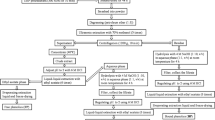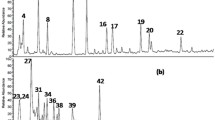Abstract
The extract of cultured Lentinula edodes mycelia (LEM) is a medicinal food ingredient that has hepatoprotective effects. In this study, we fractionated the LEM extract to explore novel active compounds related to hepatoprotection by using primary cultures of rat hepatocytes exposed to carbon tetrachloride (CCl4). The LEM extract and the fractions markedly inhibited the release of alanine aminotransferase (ALT) from hepatocytes damaged by CCl4 into the culture medium. The strongest hepatocyte-protective activity was seen in a fraction (Fr. 2) in which a 50% ethanol extract was further eluted with 50% methanol and separated using reverse-phase HPLC. Fr. 2 had an average molecular weight of 2753, and the main components are lignin (49%) and saccharides (36%, of which xylose comprises 41%). Therefore, Fr. 2 was presumed to be a low-molecular-weight compound consisting mainly of lignin and xylan-like polysaccharides. The hepatocyte-protective activity was observed even after digestion of xylan-like polysaccharides in Fr.2 and confirmed with low-molecular-weight lignin (LM-lignin) alone. In addition, Fr. 2, the xylan-digested Fr. 2 and LM-lignin showed higher superoxide dismutase (SOD)-like activity than the LEM extract. These results suggested that the effective fraction in the LEM extract related to hepatocyte protection consisted mainly of LM-lignin, and its antioxidant activity partially contributes to the hepatocyte-protective activity of the LEM extract.





Similar content being viewed by others
References
Chang R (1996) Functional properties of edible mushrooms. Nutr Rev 54:S91–S93
Itoh A, Isoda K, Kondoh M, Kawase M, Watari A, Kobayashi M, Tamesada M, Yagi K (2010) Hepatoprotective effect of syringic acid and vanillic acid on CCl4-induced liver injury. Biol Pharm Bull 33:983–987
Itoh A, Isoda K, Kondoh M, Kawase M, Kobayashi M, Tamesada M, Yagi K (2009) Hepatoprotective effect of syringic acid and vanillic acid on concanavalin a-induced liver injury. Biol Pharm Bull 32:1215–1219
Watanabe A, Kobayashi M, Hayashi S, Kodama D, Isoda K, Kondoh M, Kawase M, Tamesada M, Yagi K (2006) Protection against d-galactosamine-induced acute liver injury by oral administration of extracts from Lentinus edodes mycelia. Biol Pharm Bull 29:1651–1654
Akamatsu S, Watanabe A, Tamesada M, Nakamura R, Hayashi S, Kodama D, Kawase M, Yagi K (2004) Hepatoprotective effect of extracts from Lentinus edodes mycelia on dimethylnitrosamine-induced liver injury. Biol Pharm Bull 27:1957–1960
Yamasaki H, Kawanishi T, Matsui Y, Tamesada M, Asano K (2003) Inhibitory effect of Lentinus edodes mycelia on angiogenesis. Biotherapy (Tokyo) 17:467–472
Sugano N, Choji Y, Hibino Y, Yasumura S, Maeda H (1985) Anticarcinogenic action of an alcohol-insoluble fraction (LAP1) from culture medium of Lentinus edodes mycelia. Cancer Lett 27:1–6
Itoh M, Sano J, Sugiyama Y, Kunieda K, Sagi S (2002) Anti-tumor effect of Lentinus edodes mycelia using a rat model with high lung metastasis (GKS-HL) established in our Department. Biotherapy (Tokyo) 16:605–611
Nagashima Y, Sanpei N, Yamamoto S, Yoshino S, Tangoku A, Oka M (2005) Evaluation of host immunity and side effects in breast cancer patients treated with adjuvant chemotherapy (FEC therapy). Gan To Kagaku Ryoho 32(11):1550–1552
Ichikawa Y, Mizoguchi Y, Kobayashi K, Morisawa S (1991) Effect of extract from cultured medium of Lentinus edodes mycelia on intracellular calcium ion concentration in peritoneal exudate macrophages. J Tradit Med 54:162–166 (in Japanese)
Higashiguchi T, Ito A, Kodama Y, Nimura A, Nagaoka H, Hashimoto K, Haneda T, Sugiyama N (2008) Efficiency and safety of a Lentinus edodes mycelia-enriched diet (LEM®) in patients with chronic hepatitis C. J Anal Bio-Sci 31:204–214
Kajimoto O, Yamaguchi Y, Takeuchi T, Namba T, Shimada A, Matsumoto K, Shimazu T, Iwano M, Takahashi R (2000) Effects of Lentinus edodes mycelia-enriched diet on borderline and mild liver dysfunction: a double controlled study. J Jpn Clin Nutr 22:22–31
Tsubura E, Nishimoto M, Nishii K (1999) Effects of LEM (Lentinus edodes mycelia) for chemotherapeutic hepatic side effects in the patients with pulmonary tuberculosis. Prog Med 19:1959–1964
Seglen PO (1976) Preparation of isolated rat liver cells. Methods Cell Biol 13:29–83
Dische Z (1947) A new specific color reaction of hexuronic acids. J Biol Chem 167:189–198
Iiyama K, Wallis AFA (1988) An improved acetyl bromide procedure for determining lignin in woods and wood pulps. Wood Sci Technol 22:271–280
Hill DR, Hladun SL, Scherer S, Potts M (1994) Water stress proteins of Nostoc commune (Cyanobacteria) are secreted with UV-A/B-absorbing pigments and associate with 1,4-β-d-xylanxylanohydrolase activity. J Biol Chem 269: 7726–7734
Slater TF (1984) Free-radical mechanisms in tissue injury. Biochem J 222:1–15
Babitskaia VG, Shcherba VV (2002) Antioxidant activity in fungi degrading lignocellulose substrates. Prikl Biokhim Mikrobiol 38(2):169–173
Setzer WN (2011) Lignin-derived oak phenolics: a theoretical examination of additional potential health benefits of red wine. J Mol Model 17:1841–1845
Author information
Authors and Affiliations
Corresponding author
Rights and permissions
About this article
Cite this article
Yoshioka, Y., Kojima, H., Tamura, A. et al. Low-molecular-weight lignin-rich fraction in the extract of cultured Lentinula edodes mycelia attenuates carbon tetrachloride-induced toxicity in primary cultures of rat hepatocytes. J Nat Med 66, 185–191 (2012). https://doi.org/10.1007/s11418-011-0580-4
Received:
Accepted:
Published:
Issue Date:
DOI: https://doi.org/10.1007/s11418-011-0580-4




